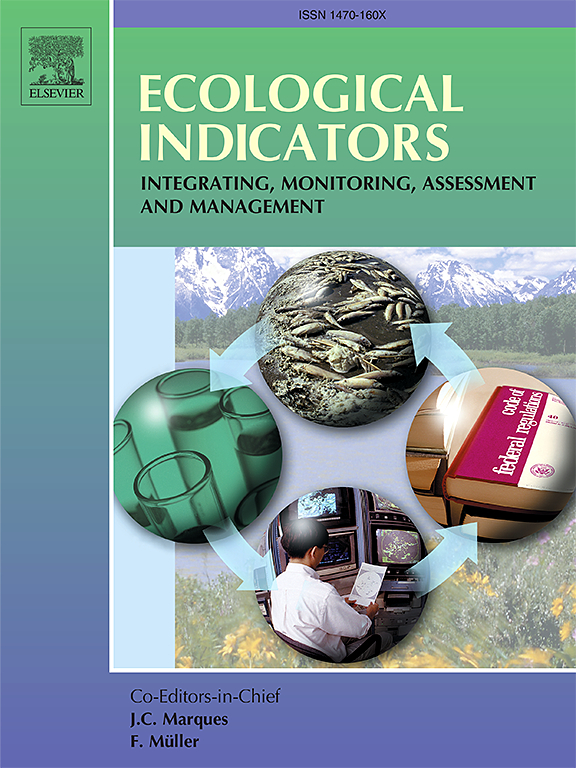中心城区二维和三维绿化指数的季节变化及空间机制
IF 7
2区 环境科学与生态学
Q1 ENVIRONMENTAL SCIENCES
引用次数: 0
摘要
绿色指数是衡量城市绿化质量的重要指标,对优化和管理城市绿地具有重要意义。然而,现有的研究大多集中在生长季节的植被生长,限制了其捕捉城市绿化的季节动态和空间影响因素的能力。为了解决这一差距,本研究以北京中心城区为例进行了研究。首先,从街景图像中提取三维绿色指数,并将其与遥感数据提取的二维绿色指数相结合,评估季节变化;分析了绿色指数的空间聚类特征以及社会经济和生物物理因素对绿色指数的影响。最后,应用多尺度地理加权回归分析了环境影响因子对绿色指数分布的空间异质性。结果表明:以街道平均值为基础,夏季综合绿化指数为0.359,冬季综合绿化指数为0.304;从各区来看,该指数从夏季到冬季平均下降了13.27%。绿色指数在冬季表现出较强的空间自相关性,二维绿色指数的聚类性高于三维绿色指数。总体而言,社会经济因素是绿色指数的主要驱动因素,而生物物理因素在夏季的影响更为显著。因此,中央商务区和丁福庄集群应优先种植常绿树种,实施多层植被结构。该研究为高密度城市环境下城市绿地系统的季节性规划和适应性优化提供了定量基础和实践见解。本文章由计算机程序翻译,如有差异,请以英文原文为准。
Seasonal variations and spatial mechanisms of 2D and 3D green indices in the central urban area
Green indices are critical indicators of urban greening quality, essential for optimizing and managing urban green spaces. However, most existing research focuses on vegetation growth during the growing season, limiting its ability to capture the seasonal dynamics and spatial impact factors of urban greening. To address this gap, this study uses the central urban area of Beijing as a case study. First, it extracts the 3D green indices from street view imagery and integrates them with the 2D green indices derived from remote sensing data to assess seasonal variations. The spatial clustering of the green indices and the impact of socio-economic and biophysical factors are then analyzed. Finally, multiscale geographically weighted regression is applied to examine the spatial heterogeneity of environmental impact factors on green indices distribution. The results show that the composite green index was 0.359 in summer and 0.304 in winter, based on subdistrict averages. Across subdistricts, the index declined by 13.27% on average from summer to winter. The green indices exhibited more substantial spatial autocorrelation in winter, with 2D green indices showing higher clustering than 3D indices. Socio-economic factors were the primary drivers of green indices overall, while biophysical factors had a more substantial impact during summer. Accordingly, the Central Business District and DingFuzhuang clusters should be prioritized for planting evergreen species and implementing a multi-layered vegetation structure. This study provides a quantitative foundation and practical insights for seasonal planning and adaptive optimization of urban green space system in densely developed urban environments.
求助全文
通过发布文献求助,成功后即可免费获取论文全文。
去求助
来源期刊

Ecological Indicators
环境科学-环境科学
CiteScore
11.80
自引率
8.70%
发文量
1163
审稿时长
78 days
期刊介绍:
The ultimate aim of Ecological Indicators is to integrate the monitoring and assessment of ecological and environmental indicators with management practices. The journal provides a forum for the discussion of the applied scientific development and review of traditional indicator approaches as well as for theoretical, modelling and quantitative applications such as index development. Research into the following areas will be published.
• All aspects of ecological and environmental indicators and indices.
• New indicators, and new approaches and methods for indicator development, testing and use.
• Development and modelling of indices, e.g. application of indicator suites across multiple scales and resources.
• Analysis and research of resource, system- and scale-specific indicators.
• Methods for integration of social and other valuation metrics for the production of scientifically rigorous and politically-relevant assessments using indicator-based monitoring and assessment programs.
• How research indicators can be transformed into direct application for management purposes.
• Broader assessment objectives and methods, e.g. biodiversity, biological integrity, and sustainability, through the use of indicators.
• Resource-specific indicators such as landscape, agroecosystems, forests, wetlands, etc.
 求助内容:
求助内容: 应助结果提醒方式:
应助结果提醒方式:


